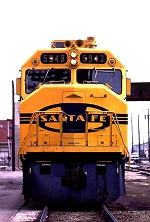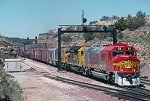ATSF FP45 93 |
|---|
 |
ATSF FP45 93 |
|---|
 |
History | |
|---|---|
 |
Santa Fe FP45 93 began life in December 1967 as Santa Fe 103. In early 1968, John Lucas caught 103 and a sister running back-to-back on the point of Train 18, the eastbound Super Chief/El Capitan at Dalies, NM. |
 |
The 103 was renumbered 5943 in March 1970 as part of the 1969/70 general renumbering. Steve Hoskins caught the unit hobnobing with an earlier generation of F at Los Angeles, CA in 1970. |
 |
The 5943 was about to depart Dearborn Station with the last westbound San Francisco Chief on April 30, 1971 when Gerry Putz snapped its portrait. Amtrak began operations the following day, and 5943 and her sisters would soon be reassigned to freight duties. |
 | The 5943 lost its steam generator and was repainted into the blue and yellow pinstripe scheme in late 1971 or early 1972. It was one of seven FP45's to receive this scheme before the blue and yellow warbonnet was introduced in June 1972. Jay Roberts found a solid set of pinstriped cowls consisting of 5943, an F45, and another FP45 standing near the Barstow, CA depot on February 26, 1972. |
 | At some point in the 70's, the original passenger 57:20 gear ratio was changed to a still-speedy 59:18, which could be put to good use on the 79 mph "Super C," an expedited Chicago - Los Angeles piggyback train. Charles Lange captured the rare spectacle of three pinstriped FP45's on one train as 5943, 5946, and 5941 lift the eastbound Super C over Cajon Pass at Sullivan's Curve on July 9, 1972. Within a few years, all three were repainted into the blue and yellow warbonnet scheme. |
 | In April 1980, 5943 was rebuilt in the Santa Fe shops at San Bernardino, CA. The gyralight between the numberboards was removed, and the fixed headlight was relocated from the nose door to the former gyralight location. The 5943 and 5945 were the only FP45's whose fixed headlights were relocated in this fashion; the rest kept their headlights in the nose door. A year after its rebuild, 5943 shows off its new look at Topeka, KS on May 27, 1981. The unit and two sisters were piloting a Director's Special from Kansas City to Emporia via Topeka that day under the symbol DSW BG-9. Later in the day, the special lays down a diesel contrail as it highballs through Pauline, KS. Note the Automatic Train Stop shoe on 5943's front journal. Bob Helling recorded both views. |
 | |
 | When there wasn't a director's special to run, an FP45 was just another freight unit in the early 80's. Four months and a layer of grime after the previous photos, 5943 was leading a mixed freight westbound through Abo Canyon in New Mexico. |
 | In early 1982, the railroad decided to renumber the rebuilt FP45's into the 5990-series, and the 5943 became the 5993. In 1986, the locomotive was painted into the short-lived SPSF red and yellow scheme. The scheme was especially short-lived on 5993; the unit was back in blue and yellow within two years. Chris Kinoshita found the unit at San Bernardino on March 9, 1986. Note that the black roofline extends down to the bottom of the radiator intake grills. On most other SPSF-painted cowls, the black ended at the 45-degree bend in the sheetmetal. |
 | The 5993 didn't spend long in SPSF paint. By 1988 it was back in blue and yellow. Joe Blackwell photographed it leading an eastbound out of Tunnel 3 above Bealville, CA on Tehachapi Pass in February 1989 ahead of a U36C still painted in the obsolete red and yellow scheme. |
 | By the time the photo at left was taken in September 1989, FP45's in blue and yellow were getting scarce as well. Half of the eight surviving FP45's had already been repainted into Superfleet red and silver warbonnet by this date. 5993 was the second-to-last FP45 repainted in red and silver. By this date, 5993's gear ratio had also been changed to a more typical freight locomotive ratio of 62:15. |
 | The 5993 emerged from repainting on January 27, 1990 wearing the number 106. At the same time, the headlight was relocated back to the nose door. The light was noticably recessed compared to the factory installations on most of the other FP45's, probably to reduce the risk of crew members burning themselves on the hot bulbs. Gary Kluge provided this David A. Dallner photograph of the glistening unit, one day out of the paint booth, at San Dernardino, CA on January 28, 1990. |
 | Bill Hough found the 106 and 103 leading a train at San Bernardino in February 1990. The Superfleet painted FP45's received new 100-series numbers more or less in the order they came from painting, not in their as-built order. It is ironic to note that locomotive 106 in the picture was delivered as the 103, and the 103 pictured was delivered as the 106! |
 | In May 1990, the 106 returned to its proper place in the number sequence when Santa Fe renumbered the FP45's back to their 5990-series numbers to make way for the new 100-class GP60M's then being delivered. The 106 became 5993 again, but kept this number for only a matter of weeks before the decision was made to renumber the FP45's into the 90-class. Paul Fryer recorded 5993 at Summit, CA on May 11, 1990 in the upper photo, and in the lower view, Gary Kluge found 5993 at a railroad-oriented public open house at the Oakland Army Base in Oakland, CA on May 19, 1990. |
 | |
 | Bob Finan caught this very rare scene of 5993 leading already renumbered FP45 #90, another FP45, and a C30-7 on eastbound train 941 near Ludlow, CA on May 27, 1990. |
 | Three months and one renumbering later, Ted Ellis caught the FP45 now known as #93 leading an eastbound at West DoubleA, AZ on August 26, 1990. The interesting consist also included an SDF40-2 (ex-Amtrak SDP40F) in blue and yellow and another red and silver FP45 (probably 91 judging from the bow in the frame). |
 | With the arrival of new locomotives in red and silver, the FP45's quickly relinquished the spotlight, appearing less and less frequently on special trains. One of 93's last hurrahs came during the 1991 Topeka Railroad Days, when it powered several special trips along with sister FP45 #96. John Hake photographed the pair at Topeka as they were about to lead a dinner train trip to Lawrence, KS. The US flag sticker was a feature added to nearly all Santa Fe locomotives during the Gulf War in 1991. |
 | In their final years of service, the FP45's were rarely seen on the point of trains due to their poor rearward visibility and various other complaints. BNSF never equipped any of the FP45's with ditch lights, so when these lights became mandatory for lead units on December 31, 1997, the big F's were permanently relegated to trailing positions. On November 8, 1998, the 93 trails two green machines on an eastbound manifest at Riverbank, CA. Less than three months later, on January 21, 1999, the 93 was laid up - bad order and placed in storage at Topeka, KS. |
 | BNSF donated the 93 to the Great Plains Transportation Museum in Wichita, KS in March 1999. The locomotive was moved to the museum in June 1999, and was placed on display beside another veteran of Santa Fe passenger service, 4-8-4 #3768. Richard Hitchcock took this photo in July, 1999. |
References |
|---|
| 1. EuDaly, Kevin, Santa Fe 1992 Annual, Denver: Hyrail Productions, 1992. |
| 2. McMillan, Joe, Santa Fe's Diesel Fleet, Chatham Publishing Co, 1975. |
| 3. McMillan, Joe, Santa Fe Motive Power, McMillan Publications, 1985. |
| 4. Shine, Joseph, Santa Fe 1987 Motive Power Review, Four Ways West Publishing, 1988. |
Back to Santa Fe Preserved Locomotives